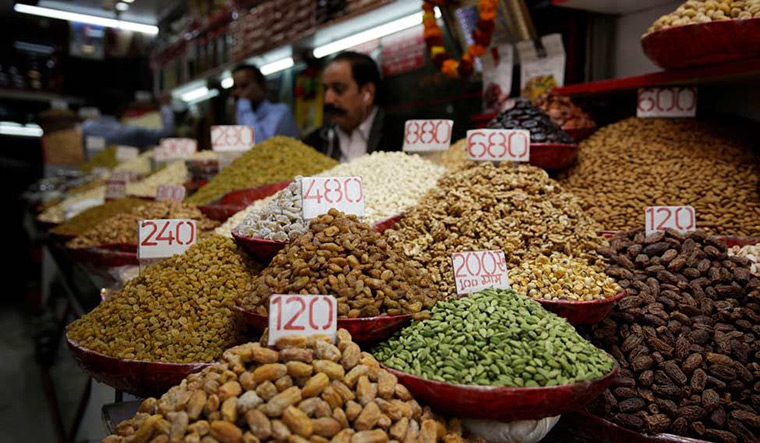Retail inflation dropped marginally to 7.01 per cent in June mainly due to slight easing in prices of vegetables and pulses, though it remained above the Reserve Bank's comfort level for the sixth month in a row.
The consumer price index (CPI) based inflation stood at 7.04 per cent in the preceding month of May and 6.26 per cent in June 2021.
Inflation in the food basket in June 2022 was 7.75 per cent, compared to 7.97 per cent in the previous month, as per the National Statistical Office (NSO) data released on Tuesday.
The RBI has the mandate to ensure that inflation remains at 4 per cent, with a margin of 2 per cent on either side. However, retail inflation is ruling above the RBI's upper tolerance limit of 6 per cent since January 2022.
As per the data, the inflation print in vegetables eased to 17.37 per cent during the month from 18.26 per cent in May, while for 'pulses and products' it slowed to (-) 1.02 per cent against (-)0.42 per cent.
However, the rate of price rise in 'cereals and products' moved up to 5.66 per cent, from 5.33 per cent in the preceding month. Inflation in the 'fuel and light' category rose to 10.39 per cent as against 9.54 per cent, while that for fruits increased to 3.10 per cent from 2.33 per cent.
Last month, the Reserve Bank in its bi-monthly monetary policy review raised the benchmark repo rate -- at which it lends short-term money to banks -- by a sharp 0.50 per cent to 4.90 per cent to rein in spiralling prices. It followed an off-cycle meeting on May 4, when the central bank hiked the repo rate by 0.40 per cent.
RBI said the global geopolitical situation remains fluid and commodity markets remain on the edge, rendering heightened uncertainty to the domestic inflation outlook.
However, certain positive developments such as expectations of a normal south-west monsoon and kharif agricultural season, recent supply side measures taken by the government as well as lifting of palm oil export ban by Indonesia may help ease the acute price pressures to some extent, RBI Governor Shaktikanta Das had said in his monetary policy statement.
The apex bank also raised its retail inflation forecast for the current financial year to 6.7 per cent from its previous estimate of 5.7 per cent.
Retail inflation in Q1 FY23 averaged to 7.3 per cent, marginally lower than the RBI's projections of 7.5 per cent, said Upasna Bhardwaj, Chief Economist, Kotak Mahindra Bank.
She said the the Monetary Policy Committee (MPC) is expected to continue to frontload policy rate hikes, especially as global monetary tightening continues. "We expect 85-110 basis points (bps) of additional rate hikes in the coming few meetings to bring the Repo rate towards 5.75 - 6 per cent by end of FY23."
The RBI has projected retail inflation at 7.4 per cent in Q2 FY23, which will reduce to 6.2 per cent in Q3 and further to 5.8 per cent in Q4.
Aditi Nayar, Chief Economist at ICRA, said the cut in excise duty on petrol and diesel drove the downtrend in the transport and communication sub-index of miscellaneous items, whereas the services sub-indices reported a pickup in inflation that needs to be watched very carefully.
"We continue to foresee front loaded rate hikes of 60 bps spread over the next two policy reviews followed by an extended pause, as the MPC will focus on containing inflationary expectations without sacrificing growth," Nayar said.
Nikhil Gupta, Chief Economist, MOFSL group, said, "We expect 25bp hike next month. Lower than expected inflation for the second consecutive month, however, is a relief."
He said going forward, headline inflation is expected to stay around 7 per cent in Q2 FY23 and ease towards 6.5 per cent in Q4.
Industry body PHD Chamber's President Pradeep Multani said, "We look forward to the further improvement in the CPI inflation on the back of various measures undertaken by the Government of India and RBI."
An SBI Research report said out of 299 commodities in the headline CPI basket, 200 could be categorised as supply-driven and the rest 99 as demand driven.
"Our results show that supply side factors are currently responsible for almost two-third of the current elevated level of CPI inflation.
"This in part reflects supply constraints from continued global supply disruptions related to the pandemic and the war in Ukraine. Demand factors contribute only one-third to CPI inflation," it said.
It further said in the recent months, demand-led CPI inflation has moved up a bit, while supply-led CPI inflation continues to moderate.
"Clearly, the RBI may have to raise rates further though, the clear downward trend in inflation attributable to supply side factors bodes quite well for inflation trajectory going forward," the report said.
The RBI will announce its next monetary policy decision on August 4.
RBI Governor Shaktikanta Das last week had said the price situation will gradually improve in the second half of the current fiscal, adding that the central bank would continue to take monetary measures to anchor inflation with a view to achieving strong and sustainable growth.
He said price stability is key to maintaining macroeconomic and financial stability and the central bank will undertake necessary measures for the same.





